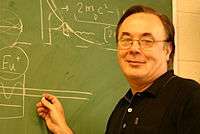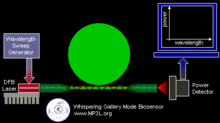Stephen Arnold (scientist)
| Stephen Arnold | |
|---|---|
 | |
| Born | New York |
| Nationality | American |
| Education | City University of New York, University of Toledo |
| Occupation | Professor of Physics and Chemical Engineering |
| Organization | NYU Polytechnic School of Engineering |
Stephen Arnold is a Professor of Physics and Chemical Engineering and the Thomas Potts Professor of Physics at the NYU Polytechnic School of Engineering.[1] He is also an Othmer-Potts Senior Faculty Fellow. The focus of Arnold's research is developing ultra-sensitive bio-sensors and detection of single bio-nanoparticles from virus down to single protein molecules, using Whispering-gallery wave bio-sensors.[2]
Education
Arnold holds a Ph.D. in Physics from the City University of New York and a Bachelor of Science in Engineering Physics from the University of Toledo.[3]
Career
Arnold worked at the Ecole Normale Superieure, Paris, from March 1972 to September 1973. In 1981, he was named a fellow of the Alfred P. Sloan Foundation. Arnold was a Chevron distinguished visiting professor at the California Institute of Technology from February 1985 to May 1985. In 1986, he was awarded the Sigma Xi Award for Distinguished Scientific Research. In 1988, he became a Fellow of the Optical Society of America. He worked at the Aerospace Corporation as a technical staff member from February 1990 to May 1990 and became a Fellow of the American Physical Society in 1990. In 1994, he received the Outstanding Publication Award at Oak Ridge National Laboratory. Arnold was a visiting scholar at the University of Tokyo from February 1997 to May 1997.[3] In 2000, The University of Toledo awarded him the John J. Turin Award for Outstanding Career Accomplishments in Physics.[4]
Arnold became director of the Othmer Institute for Interdisciplinary Research at NYU Polytechnic July 2003.[5] In February 2009, he was issued a patent from a filing in March 2002 for Detecting and/or Measuring Substance based on Resonance Shifts (of Photons Orbiting within a Microsphere).[6] He was a vising scholar at Harvard University from January until June 2013.[3] Arnold is a University Professor of Physics and Chemical Engineering at the NYU Polytechnic School of Engineering and is the Thomas Potts Professor of physics.[1]

Research
Arnold's research has focused on label-free detection of bio-nanoparticles from the perturbation of the resonant frequency of a microcavity, after estimating the extreme sensitivity of such an approach for DNA sensing in a 2001 American Scientist article.[7] In 2003, he and his co-workers identified the mechanism for the detection of individual protein and viruses.[8] The recipe for the detection and sizing of single HIV viruses following this mechanism was proposed early in 2008 at a Faraday Discussion of the Royal Society of Chemistry.[9] Later that year, this recipe was applied to the detection and sizing of comparably sized single Influenza virus particles.[10] This research is funded by the National Science Foundation.[11] Researchers led by Arnold demonstrated the detection and sizing of the smallest individual RNA virus.[12] They developed the Whispering Gallery-Mode Biosensor,[13] an ultra-sensitive biosensor[2] based on their original proposal and patent application. An additional discovery by co-researcher S.I. Shopova that gold nano-receptors on the microcavity lead to a further frequency shift enhancement led to another patent issued in 2013, from a filing in 2011.[14] This hybrid sensor uses gold nano-antennas on a small glass sphere to detect single ultra-small virus particles as well as individual proteins.[15] Arnold and his team have detected single thyroglobulin molecules, a human cancer marker protein, and single serum albumin molecules, a bovine plasma protein.[16][17]
Selected publications
- Stephen Arnold, David Keng, "Real-time Size/Mass Spectrometry in Solution using Whispering Gallery Micro-Global Positioning", Optical Society of America (2015).
- S. Holler, V.R. Dantham, D. Keng, V. Kolchenko, S. Arnold, Brigid Mulroe, M. Paspaley-Grbavac, "The Whispering Gallery Mode Biosensor: Label-free Detection From Virus to Single Protein", International Society for Optics and Photonics (2014).
- V.R. Dantham, S. Holler, Z. Wan, V. Kolchenko, S. Arnold, "Taking Whispering Gallery Mode Single Virus Detection and Sizing to the Limit", Appl. Phys. Lett. 101, 043704(2012).
- S. I. Shopova, R. Rajmangal, S. Holler, S. Arnold, "Plasmonic Enhancement of a Whispering Gallery Mode Biosenor for Single Nanoparticle Detection", Applied Physics Letters 98, 243104(2011).
- S. I. Shopova, R. Rajmangal, Y. Nishida, S. Arnold, “Ultra-sensitive Nanoparticle Detection using a Portable Whispering Gallery Mode Biosensor driven by a PPLN doubled DFB laser”, Rev. Scientific Instruments 81, 103110 (2010).
- S. Arnold, S.I. Shopova, and S. Holler, "Whispering Gallery Mode Bio-sensor for label-free detection of single molecules: thermo-optic vs. reactive mechanism, Optics Express 18, 281-287(2010).
- F. Vollmer and S. Arnold, "Whispering-gallery-mode biosensing: label-free detection down to single molecules", Nature Methods, 5, 591-596 (2008).
- S. Arnold, R. Ramjit, D. Keng, V. Kolchenko, and I. Teraoka, “MicroParticle PhotoPhysics Illuminates Viral Biosensing”, Faraday Discussions, 137, 65-83 (2008).
- Stephen Arnold, “Microspheres, Photonic Atoms and the Physics of Nothing”, American Scientist, 89, 414-421 (2001).
References
- 1 2 "A nanoplasmonic sensor detects cancer proteins at the single-molecule level". SPIE. September 30, 2013. Retrieved September 14, 2015.
- 1 2 David Szondy (August 28, 2012). ""Whispering gallery" biosensor detects the smallest viruses". Giz Mag. Retrieved September 14, 2015.
- 1 2 3 "Stephen Arnold | NYU-Poly". Poly.edu. 2009-02-17. Retrieved 2012-11-20.
- ↑ "John J. Turin Award and Convocation". University of Toledo. Retrieved September 14, 2015.
- ↑ "Researchers set record for detecting smallest virus, opening possibilities for early disease detection". Phys.org. August 28, 2012. Retrieved September 14, 2015.
- ↑ S. Arnold; I. Teraoka. "Patent US7491491 - Detecting and/or measuring a substance based on a resonance shift of photons ... - Google Patents". Google.com. Retrieved 2012-11-20.
- ↑ Stephen Arnold (2001). "Microspheres, Photonic Atoms and the Physics of Nothing". American Scientist. 89: 414–421. doi:10.1511/2001.5.414.
- ↑ S. Arnold; M. Khoshsima; I. Teraoka; S. Holler; F. Vollmer (2003). "Shift of whispering gallery modes in microspheres by protein adsorption". Optics Letters. 28: 272–274. doi:10.1364/ol.28.000272.
- ↑ S. Arnold; R. Ramjit; D. Keng; V. Kolchenko; I. Teraoka (2008). "MicroParticle PhotoPhysics Illuminates Viral Biosensing". Faraday Discussions. 137: 65–83. doi:10.1039/b702920a.
- ↑ F. Vollmer; S. Arnold & D. Keng (December 2008). "Single virus detection from the reactive shift of a whispering-gallery mode". PNAS. 105 (52): 20701–4. doi:10.1073/pnas.0808988106.
- ↑ "Groundbreaking research leads to detection of smallest virus particle, implications for early treatment of disease". Phys.org. December 19, 2012. Retrieved September 14, 2015.
- ↑ V. R. Dantham; S. Holler; V. Kolchenko; Z. Wan & S. Arnold (July 2012). "Taking whispering gallery-mode single virus detection and sizing to the limit". Applied Physics Letters. 101 (4). doi:10.1063/1.4739473.
- ↑ F. Vollmer & S. Arnold (2008). "Whispering-gallery-mode-biosensing: label-free sensing down to single molecules". Nature Methods. 5: 591–596. doi:10.1038/nmeth.1221.
- ↑ S.I. Shopova; S. Arnold; R.H. Rajmangal. "Patent US8493560 - Plasmonic enhancement of Whispering Gallery Mode Biosensors". Google.com. Retrieved September 14, 2015.
- ↑ Marsha Lewis (July 25, 2013). "Exposing the Smallest Viruses". Inside Science. Retrieved September 14, 2015.
- ↑ James Devitt (July 20, 2013). "Sensor detects Incredibly Small Cancer Marker". Futurity. Retrieved September 14, 2015.
- ↑ V. R. Dantham; S. Holler; C. Barbre; D. Keng; V. Kolchenko; S. Arnold (2013). "Label-free detection of single protein using a nanoplasmonic-photonic hybrid microcavity" (PDF). Nano Letters. 13: 3347–2251. doi:10.1021/nl401633y.